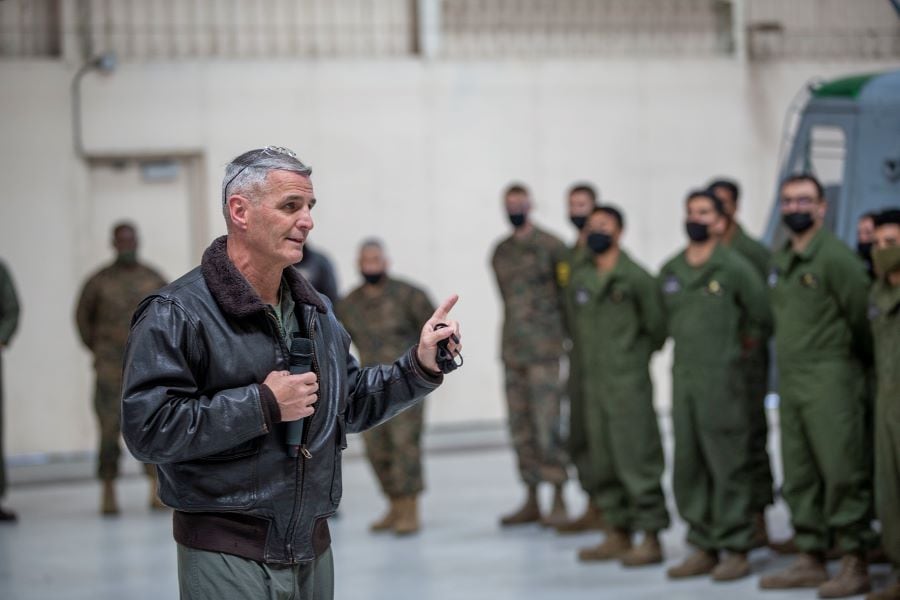When speaking at a recent Marine Corps Association event, a prominent Marine Corps officer erroneously and liberally alleged that some retired officers are either mistakenly or intentionally misrepresenting key aspects of Force Design 2030. (See “Marine 3-star ‘myth-busts’ notions about Force Design 2030.”)
The speaker’s tangled web of false allegations that these officers are either ill-informed or duplicitous quickly unravel when exposed to even the most cursory analysis. Many Marines — former, retired and active duty — have valid concerns about the current direction of the Marine Corps.
One-sided theatrics focused on “myth-busting” may be entertaining, but melodramatics fail to address the larger issue. What we should be debating is a vision for the Marine Corps that best meets the nation’s national security interests in an increasingly dangerous world. The current approach does not.
Force Design 2030 is an unproven concept that focuses on the certainty of a known threat in a specific location. The strategy is defensive, based on the unverified assumption that the proliferation of precision munitions and advanced sensors has changed the character of war, rendering the defense decisively dominant over the offense.
RELATED

To acquire the innovations needed for this new concept, the Marine Corps divested organizations and equipment needed today to self-fund future, largely experimental capabilities that will not be fully fielded in sufficient quantities until 2030 or beyond. As a result, I believe the Marine Corps will no longer be able to respond quickly and effectively to current and subsequent threats worldwide. Global response has been replaced by a narrowly focused one-dimensional, largely regional future force known as “stand-in forces.”
These small teams are envisioned to be widely distributed and essentially isolated among the first island chain of the Western Pacific. The mission of the stand-in forces is to acquire and sink Chinese warships with mid- to long-range missiles.
Force Design 2030 wrongly assumes that this redesigned and reconfigured force has global utility across the spectrum of conflict. It does not.
A group of senior, retired Marines have argued that Force Design 2030 poses significant risks to national security. This group, loosely known as Chowder II (after the original Chowder Society that saved the Marine Corps from institutional destruction as a separate service in 1947), has advocated for a Marine Corps that can respond quickly and effectively to global crises and contingencies across the spectrum of conflict.
Chief among Chowder II’s concerns is the unwise strategy of “divest to invest.” Other concerns are Force Design 2030′s almost exclusive focus on a single threat, in a known location and the Corps’ failure to use a rigorous combat development process to validate the concept.
We believe the Marine Corps should be focused instead on the uncertainties of global threats, which requires the ability to conduct offensive operations.
Our vision reduces risk to national security. By leveraging innovation, technology and the combat development process, the Marine Corps can regain its offensive capabilities, which will enable Marine forces to respond quickly and effectively anywhere in the world.
History informs us that wars are more quickly terminated when one side or the other maneuvers to achieve decisive results. Defensive operations are an invitation to a stalemate.
One of the lessons from the Cold War was that the focus on the Soviet Union did not reduce the number of lesser threats. A belligerent Iran, a recalcitrant North Korea and other hostile players will continue to threaten national security. The nation requires a Corps capable of responding to a wide array of global threats quickly and decisively.
Chowder’s II vision for the Corps is a distinct alternative to Force Design 2030. A nation without the capability to respond globally to emerging threats risks wider wars, not only with peer competitors but with a host of other state and nonstate state actors.
Lt. Gen. Paul Van Riper (retired) is an infantry officer with prior enlisted service who led Marines at every level from a fire team to a division. He participated in combat during four tours.





